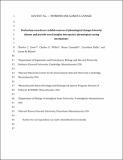| dc.contributor.author | Davis, Charles Cavender | |
| dc.contributor.author | Willis, Charles George | |
| dc.contributor.author | Connolly, Bryan | |
| dc.contributor.author | Courtland, Kelly | |
| dc.contributor.author | Ellison, Aaron M. | |
| dc.date.accessioned | 2015-09-24T19:07:17Z | |
| dc.date.issued | 2015 | |
| dc.identifier | Quick submit: 2015-09-22T11:53:21-04:00 | |
| dc.identifier.citation | Davis, Charles C., Charles G. Willis, Bryan Connolly, Courtland Kelly, Aaron M. Ellison. 2015. Herbarium records are reliable sources of phenological change driven by climate and provide novel insights into species’ phenological cueing mechanisms. American Journal of Botany 102 (10): 1599-1609. | en_US |
| dc.identifier.issn | 0002-9122 | en_US |
| dc.identifier.uri | http://nrs.harvard.edu/urn-3:HUL.InstRepos:22812360 | |
| dc.description.abstract | Premise of the study: Climate change has resulted in major changes in the phenology of some species but not others. Long-term field observational records provide the best assessment of these changes, but geographic and taxonomic biases limit their utility. Plant specimens in herbaria have been hypothesized to provide a wealth of additional data for studying phenological responses to climatic change. However, no study to our knowledge has comprehensively addressed whether herbarium data are accurate measures of phenological response, and thus applicable to addressing such questions. Methods: We compared flowering phenology determined from field observations (years 1852-1858; 1875; 1878-1908; 2003-2006; 2011-2013) and herbarium records (1852-2013) of 20 species from New England, USA. Key Results: Earliest flowering date estimated from herbarium records faithfully reflected field observations of first flowering date and substantially increased the sampling range across climatic conditions. Additionally, although most species demonstrated a response to inter-annual temperature variation, long-term temporal changes in phenological response were not detectable. Conclusions: Our findings support the use of herbarium records for understanding plant phenological responses to changes in temperature, and also importantly establish a new use of herbarium collections: inferring primary phenological cueing mechanisms of individual species (e.g., temperature, winter chilling, photoperiod). These latter data are lacking from most investigations of phenological change, but are vital for understanding differential responses of individual species to ongoing climate change. | en_US |
| dc.description.sponsorship | Organismic and Evolutionary Biology | en_US |
| dc.language.iso | en_US | en_US |
| dc.publisher | Botanical Society of America | en_US |
| dc.relation.isversionof | 10.3732/ajb.1500237 | en_US |
| dash.license | OAP | |
| dc.subject | climate change | en_US |
| dc.subject | climate variablity | en_US |
| dc.subject | phenology | en_US |
| dc.subject | herbarium specimens | en_US |
| dc.subject | 72 museum collections | en_US |
| dc.title | Herbarium records are reliable sources of phenological change driven by climate and provide novel insights into species’ phenological cueing mechanisms | en_US |
| dc.type | Journal Article | en_US |
| dc.date.updated | 2015-09-22T15:53:17Z | |
| dc.description.version | Accepted Manuscript | en_US |
| dc.rights.holder | C.C. Davis, C. G. Willis, B. Connolly, C. Kelly, and A. M. Ellison | |
| dc.relation.journal | American Journal of Botany | en_US |
| dash.depositing.author | Davis, Charles Cavender | |
| dc.date.available | 2015-09-24T19:07:17Z | |
| dc.identifier.doi | 10.3732/ajb.1500237 | * |
| dash.contributor.affiliated | Willis, Charles G. | |
| dash.contributor.affiliated | Ellison, Aaron | |
| dash.contributor.affiliated | Davis, Charles | |


